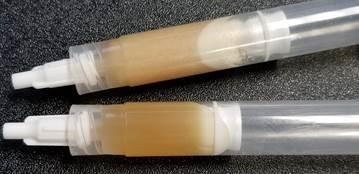Perhaps one of the most maddening things about a mixed material is entrained bubbles. Depending on how you mix, you may entrain none, or a ton of them. You want to stab them, push them and blow on them. Anything to break them. But in many photonics applications they are so tiny you can only see them under magnification. Before you tear your hair out, read further.
Without a doubt the best way to mix two fluids, air free, is with a speed mixer, or dual asymmetric centrifuge. Such mixers use two types of centrifugal forces to non-invasively and thoroughly mix the contents in disposable mix jars. They do a great job. The only down side is they are expensive.
Any other kind of mechanical mixing entrains air. Standard methods of dealing with bubbles are centrifuging and vacuuming. These are generally rapid and effective ways of vanquishing bubbles. However, if there are still some lingering bubbles, or you don’t have either of these pieces of equipment, let physics be your guide and defeat them naturally.
centrifuge
The most direct method to de-gas an unfilled epoxy is to centrifuge. After mixing the epoxy (i.e., in the bi-pack), transfer the epoxy to the final dispensing container, usually a syringe (don’t forget the tip cap). Add the piston to the syringe to capture the epoxy, bubbles and all, in the syringe. After review of the material to determine best centrifuge duration and RPM (see application note), spin the syringe in a centrifuge. The bubbles will collect into one air bubble in the barrel of the syringe, against the piston. I recommend leaving this air bubble alone and keeping the syringe in the vertical position (tip down) after centrifuging. Depending on the length of the applicator tip, the air against the piston will never actually get dispensed. If you think you must get rid of this air, a long dissecting needle can be used to create a small air gap between the piston and syringe inside wall, to effectively purge this air bubble and reseat the piston further into the syringe.
Application Note:
It is a natural misconception to run the centrifuge as long and as fast as possible, but that can just cause separation of the material (resin from fillers), especially in filled epoxy systems.
Centrifuging recommendations:
For filled epoxy systems, 1000 RPM for 2-3 minutes is normally sufficient. For unfilled epoxy systems, 3000-3500 RPM for 2-5 minutes will accommodate variation in centrifuge capabilities and variation in operator mixing. 5 minutes @ 3400 rpm is acceptable and seemingly widespread in the fiber optic industry. Please consult your epoxy manufacturer for further detail as these are general guidelines only.

Here is an example of a syringe centrifuged at 3400 RPM for 10 minutes which caused separation of material.
vacuum
Another way to de-gas is to vacuum the bubbles out of solution. This is generally best applied to materials that are in open containers, with good surface area exposure to the interior vacuum space and plenty of extra room in the container for expansion of the bubbles before they collapse. Hopefully you have a strong pump that can create a vacuum of at least 29 inches of Hg quickly. Applying and breaking the vacuum expands and contracts the bubbles in the mixture, eventually breaking the surface tension of the bubbles. Once a mixture is bubble free, it is important to realize that every time you pour or transfer the mixture, there is a new opportunity to entrain bubbles again. So it makes sense to degas mixtures, if possible, in the containers that will be used immediately for dispensing.
If you don’t have a centrifuge, or a vacuum pump, there are still ways to defeat bubbles naturally.
buoyancy and diffusion
Place your thoroughly mixed material in the refrigerator (5 to 10ºC) to slow down the cure process and preserve the pot life. Let the mixture stand in the refrigerator for several hours (depending on pot life, overnight might be a possibility). This will permit bubbles to rise and dissipate (buoyancy) and will also permit dissolved air to diffuse to the surface and equilibrate with the ambient air (diffusion). The main disadvantage of this approach is that it consumes some pot life. A minor disadvantage (to be aware of) is that once the refrigerated material is brought back to room temperature, care must be taken to prevent condensation of moisture onto the material. Condensation will occur when the ambient dew point is higher than the refrigeration temperature. In most cases, if the ambient air is actively air-conditioned to 68ºC or below, and the refrigerator is at 5ºC or greater, condensation will not occur.
2-stage heat cure
One final method to encourage bubbles to come out of the bulk material is a 2-stage heat cure. This is a short, initial cure at an elevated, but lower, temperature than the final cure. An example is a 50°C cure for 30 minutes, for a product that has a final cure at 85°C. The effect of the initial elevated heat step is to expand any bubbles that are still in, or recently introduced into – by pouring, injecting, or otherwise filling a cavity – the epoxy, increasing their size and buoyancy, encouraging them to rise out of the epoxy and escape. This elevated heat step also lowers the viscosity of the epoxy, without strongly driving the curing reaction, further enabling any expanded bubbles to rise and escape from the epoxy.
dual asymmetric centrifuge
A dual asymmetric centrifuge is a mixer that combines centrifugal type rotation (rotation around a point outside the sample holder) with rotation around the central axis of the sample holder. This combination of opposing forces enables rapid mixing of the contents of the sample holder, without entraining any air. Sample holders are sized to balance the load during mixing. After mixing the material is transferred to the vehicle used for dispensing. This is a very effective way to thoroughly mix small quantities of materials with no air bubbles.



